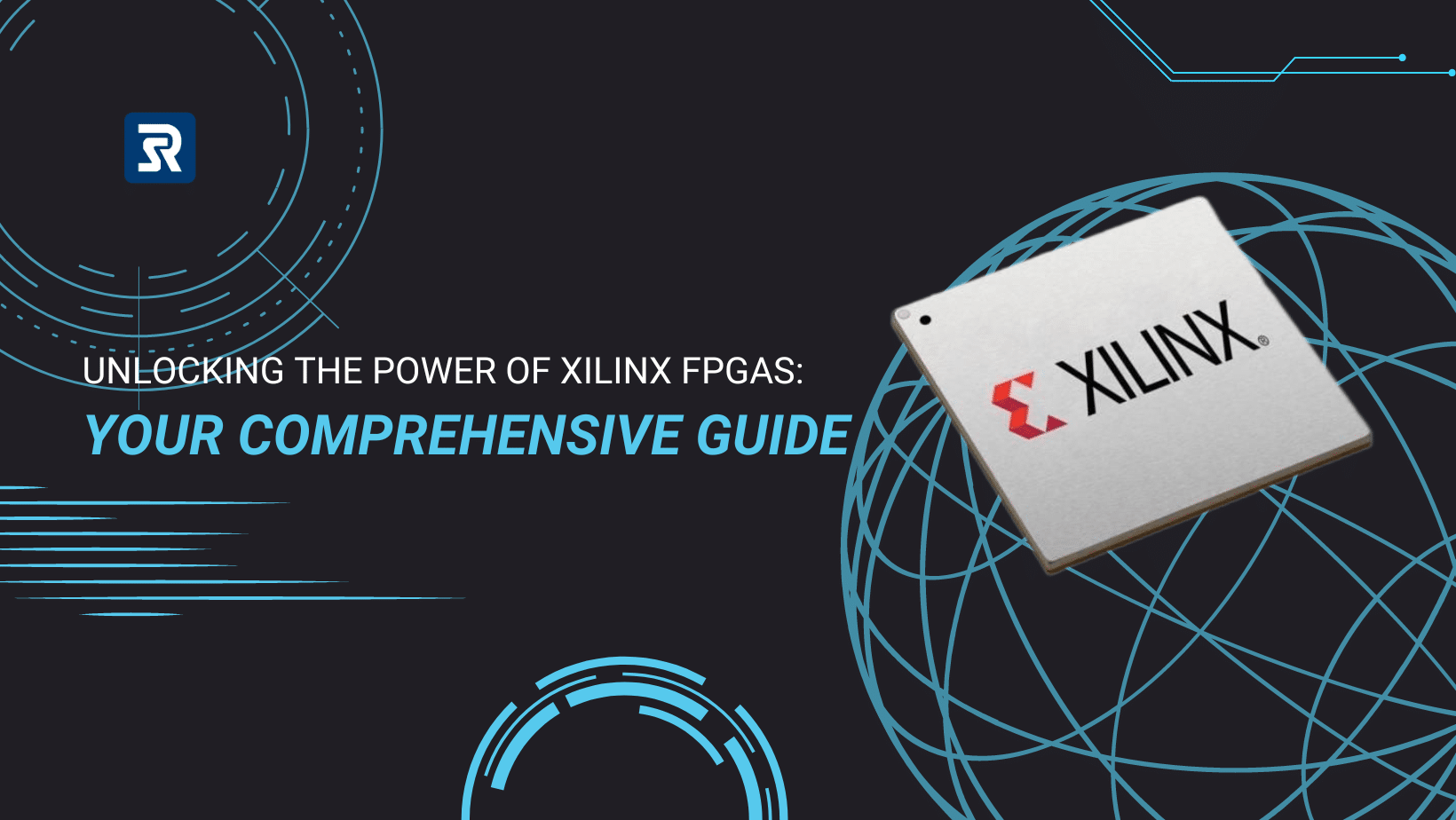Introduction: A Deep Dive into Xilinx and the World of FPGAs
Xilinx, Inc., established in 1984 and headquartered in the United States, is a global leader in Field Programmable Gate Arrays (FPGAs) and other programmable logic devices. The company pioneered the FPGA industry, launching its first commercial product in 1985. Over the years, Xilinx has continually innovated, breaking architectural and performance barriers with the release of its Virtex® FPGA series in 1994 and the 28nm Zynq® devices in 2012. These devices were the first of their kind to support application processors and include a complete System on Chip (SoC) with cache, memory controllers, peripherals, FPGA logic, DSP modules, and SerDes modules.
Xilinx’s second-generation Zynq SoC, known as Heterogeneous MPSoC, was introduced in 2017, adding new processing engines aimed at optimizing complex system processing requirements. In 2018, the company launched Alveo™ Data Center Accelerator Cards, simplifying the development and deployment of data center FPGA acceleration. In 2019, Xilinx unveiled its Adaptive Compute Acceleration Platform (ACAP) called Versal, which supports multiple Domain-Specific Architectures (DSAs) and computing structures.
The company develops, manufactures, and sells a wide range of advanced integrated circuits, software design tools, and pre-defined system-level IP cores. With a market share of over 50% and annual revenue of $1.91 billion in 2008, Xilinx is the go-to solution for programmable logic solutions worldwide. Their award-winning products, including silicon chips, software, IP, development boards, and starter kits, enable designers to deliver applications for various end markets, such as aerospace/defense, automotive, consumer, industrial, and wired/wireless communications, among others.
Xilinx offers comprehensive and diverse product lines in the FPGA device sector, covering process technologies from 45nm to 16nm. Whether you are looking for cutting-edge performance, balanced mid-range products, or cost-effective low-end solutions, Xilinx has something for everyone.
The company has significant operational facilities in Colorado, Ireland, Japan, and Singapore. It went public on NASDAQ (NASDAQ: XLNX) in 1990 and has maintained a healthy operational cash flow ever since. In the fiscal year 2008, the company’s revenue in the Asia-Pacific region accounted for 29% of global total revenue.
Xilinx® 7 Series: An In-Depth Analysis
The Xilinx® 7 Series represents a versatile and comprehensive range of Field-Programmable Gate Arrays (FPGAs), each designed to meet specific needs in various applications. This section aims to provide an in-depth analysis of this particular series, focusing on its technical specifications, features, and applications.
Virtex-7 Series: The Pinnacle of Performance
The Virtex-7 Series stands as a testament to high-performance computing in the FPGA landscape. Optimized for the highest system performance and capacity, this series offers a 2x improvement in system performance. Utilizing Stacked Silicon Interconnect (SSI) technology, the Virtex-7 Series represents the pinnacle of FPGA capabilities.
Key Technical Features
- Model Numbers: XC7V585T, XC7V2000T, XC7VX330T, XC7VX415T, XC7VX485T, XC7VX550T, XC7VX690T, XC7VX980T, XC7VX1140T, XC7VH580T, XC7VH870T
- Advanced SSI Technology: Enables superior performance and system integration.
- Comprehensive Multi-Node Product Range: Covering 45nm-16nm process nodes.
Applications
- Custom triggering
- Hardware-timed test sequencing
- Medical imaging
- Large-scale physical control and monitoring
- Ultra-wideband communications and radar
For a detailed look at the technical advantages of the Virtex-7 Series, refer to the official Xilinx Virtex-7 Series page and the specification document.
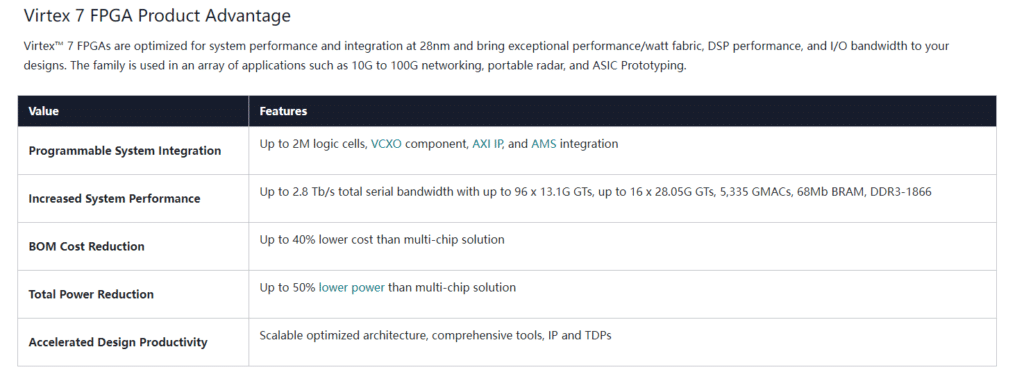
Zynq-7 Series: The Fusion of Processing and Logic
The Zynq-7 Series is a groundbreaking family of FPGAs that combine the versatility of programmable logic with the power of an ARM-based processor, all in a single chip. This unique fusion enables the development of highly integrated, high-performance systems for a wide range of applications, from embedded systems to data centers.
Key Technical Features
Model Numbers:
- Zynq 7000S: XC7Z007S, XC7Z012S, XC7Z014S
- Zynq 7000: XC7Z010, XC7Z015, XC7Z020, XC7Z030, XC7Z035, XC7Z045, XC7Z100
Integrated ARM-based Processor: Enables seamless software-hardware interaction.
High I/O Flexibility: Supports a wide range of peripheral interfaces, making it ideal for embedded systems.
Advanced Security Features: Includes secure boot, encrypted bitstreams, and tamper detection.
Applications
- Embedded systems
- Industrial automation
- Medical devices
- Data centers
- Networking equipment
For a more comprehensive understanding of the Zynq-7 Series, you can refer to the official Xilinx Zynq-7 Series page and the specification document.
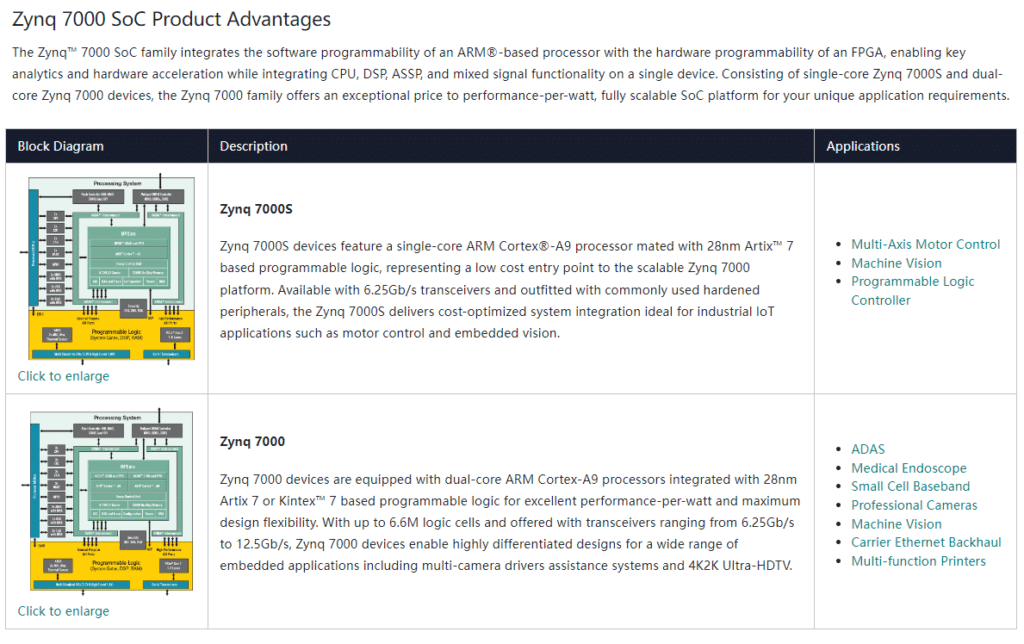
Kintex-7 Series: Bridging the Gap Between Performance and Affordability
The Kintex-7 Series is a game-changer in the FPGA market, offering an unparalleled blend of performance, power efficiency, and cost-effectiveness. Designed with a 28nm process, this series is tailored for applications that demand high DSP ratios and support for mainstream standards like PCIe® Gen3 and 10 Gigabit Ethernet.
Key Technical Features
Model Numbers: XC7K70T, XC7K160T, XC7K325T, XC7K355T, XC7K410T, XC7K420T, XC7K480T
- Versatility in Design: Whether you’re working on 3G/4G wireless applications, flat panel displays, or video over IP solutions, the Kintex-7 Series has got you covered.
- DSP-Rich Architecture: Ideal for applications requiring intensive digital signal processing, such as medical imaging or radar systems.
- Mainstream Standards Support: With native support for PCIe® Gen3 and 10 Gigabit Ethernet, this series is ready for the future of connectivity.
- Cost-Optimized Packaging: The series offers a range of cost-effective packaging options, making it accessible for various project budgets.
Applications
- Next-gen wireless communication systems
- High-resolution display technologies
- Advanced networking solutions
- Real-time video processing
- Cutting-edge industrial automation
For a more detailed understanding of the Kintex-7 Series, please refer to the official Xilinx Kintex-7 Series page and the specification document.
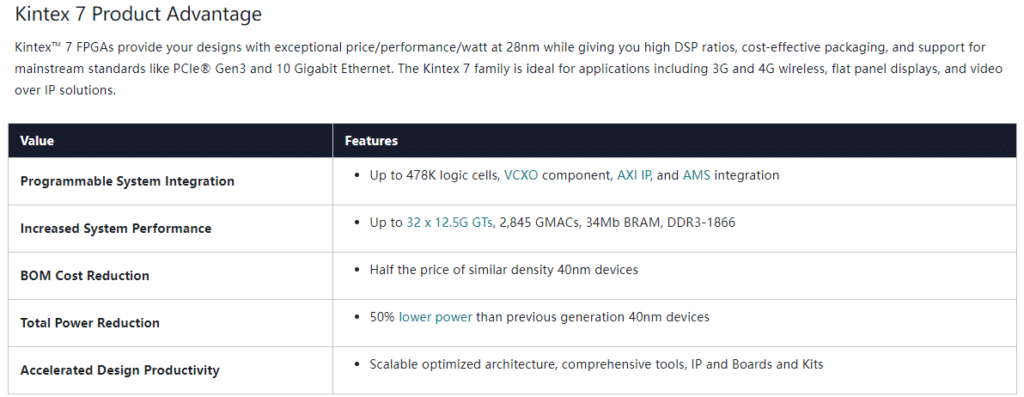
Artix-7 Series: The Ideal Choice for Cost-Sensitive Applications
The Artix-7 Series is designed with cost-sensitive applications in mind, offering a blend of low power consumption and high-performance logic and I/O capabilities. This makes it an ideal choice for a wide range of applications, from automotive and industrial to consumer electronics.
Key Technical Features:
- Model Numbers: XC7A12T, XC7A15T, XC7A25T, XC7A35T, XC7A50T, XC7A75T, XC7A100T, XC7A200T
- Low Power Consumption: Specifically optimized for low-power applications, making it a sustainable choice.
- High-Performance Logic: Equipped with high-speed logic gates that enable complex computations and system functions.
- Flexible I/O: Supports a diverse range of I/O standards, offering greater flexibility in system design.
- Integrated Memory: Comes with integrated block RAM and UltraRAM, providing ample storage for data-intensive tasks.
Applications:
- Automotive control systems
- Industrial automation
- Video and image processing
- Consumer electronics
- Networking equipment
For a more comprehensive understanding of the Artix-7 Series, you can refer to the official Xilinx Artix-7 Series page and the specification document.
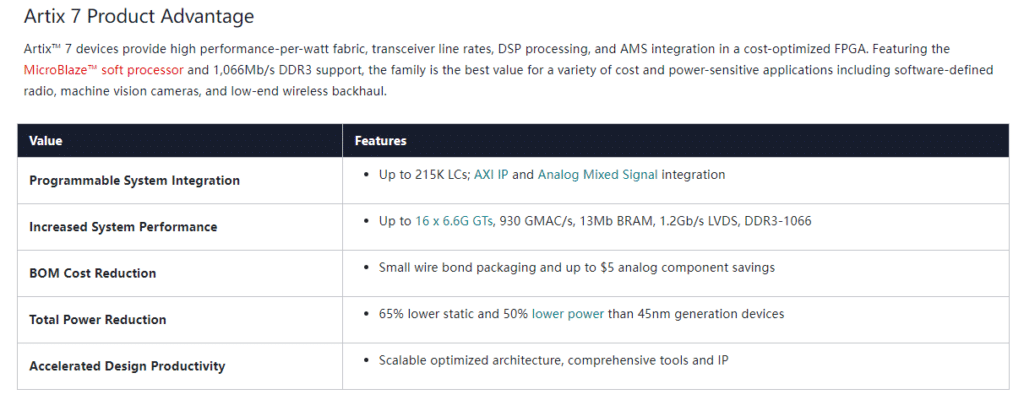
Spartan-7 Series: The Go-To Solution for Cost-Sensitive Applications
The Spartan-7 Series is the latest gem in Xilinx’s Cost-Optimized Portfolio, designed to offer a balanced mix of power, performance, and price. These devices are particularly well-suited for cost-sensitive applications that still require high performance and low power consumption.
Key Technical Features
- Model Numbers: XC7S15-1FTGB196C, XC7S15-2CSGA225I, XC7S25-1CSGA225I, XC7S75-2FGGA484C, XC7S75-1FGGA676I, XC7S100-L1FGGA676I, XC7S100-2FGGA676I
- Versatility in Connectivity: Ideal for applications that require a variety of I/O options without compromising on pin-count.
- Security Measures: Comes with built-in security features, ensuring data integrity and secure boot options.
- Efficiency in Performance: Designed to outperform its predecessors, offering a 30% speed advantage over 45nm devices.
Applications
- Industrial IoT: Perfect for sensor data aggregation and real-time analytics.
- Consumer Electronics: Ideal for wearables and smart home devices.
- Automotive Systems: Suitable for in-car entertainment systems and advanced driver-assistance systems (ADAS).
For a more in-depth look at the Spartan-7 Series, please refer to the official Xilinx Spartan-7 Series page and the specification document.
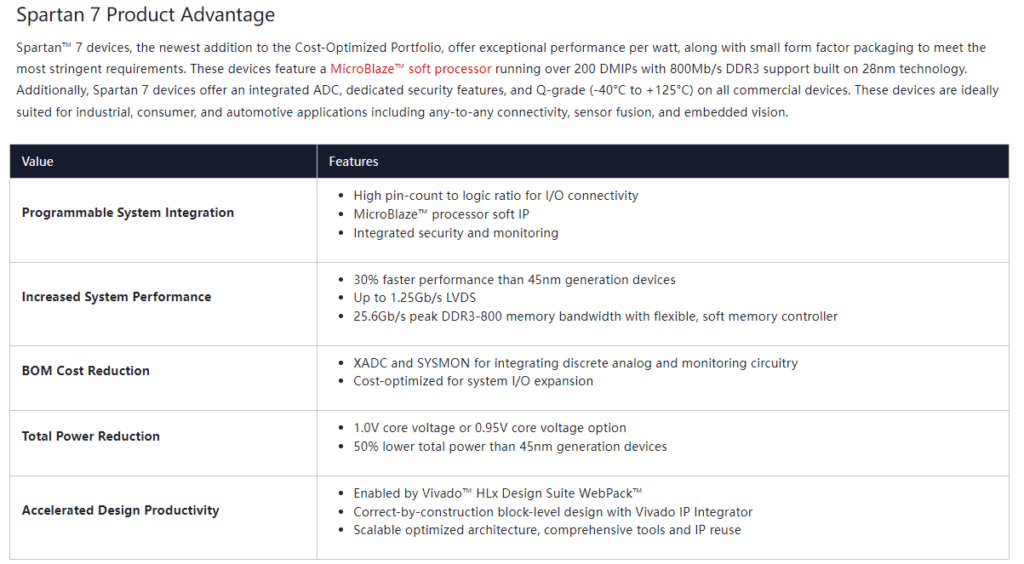
Xilinx® 6 Series: A Comprehensive Exploration
The Xilinx® 6 Series encompasses a diverse and robust lineup of Field-Programmable Gate Arrays (FPGAs), each tailored to address particular requirements across a multitude of applications. This section is dedicated to offering a thorough examination of the 6 Series, shedding light on its technical attributes, unique features, and potential use-cases.
Virtex-6 Series: The Workhorse of High-Performance Computing
The Virtex-6 Series is engineered for applications that require high computational capabilities and superior bandwidth. Built on a 40nm process technology, these FPGAs offer a blend of high-speed transceivers, advanced power management, and high-density logic cells.
Key Technical Features
- Model Numbers: XC6VLX75T, XC6VLX130T, XC6VLX195T, XC6VLX240T, XC6VLX365T, XC6VLX550T, XC6VLX760, XC6VSX315T, XC6VSX475T
- High-Speed Transceivers: Supports up to 36.8 Gbps, facilitating rapid data transfers.
- Power Management: Advanced power-saving features, including dynamic power gating and voltage scaling.
- Logic Density: Up to 760K logic cells, providing ample room for complex designs.
Applications
- High-frequency trading platforms
- Data analytics engines
- Advanced driver-assistance systems (ADAS)
- Video encoding and decoding
For a comprehensive understanding of the Virtex-6 Series, you can refer to the official Xilinx Virtex-6 Series page and the specification document.
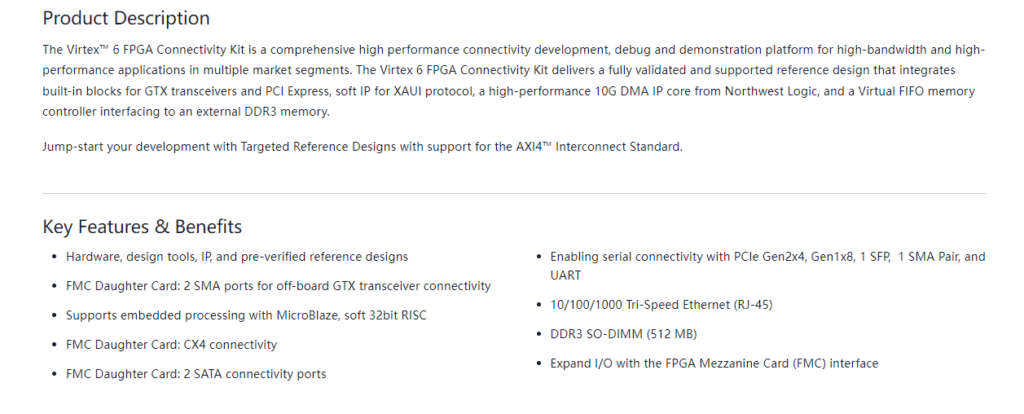
Spartan-6 Series: Tailored for Versatile Applications
The Spartan-6 Series stands out for its adaptability and efficiency, making it a strong choice for a variety of sectors, including consumer electronics, automotive, and industrial automation. Built on a 45nm process, this series is optimized for both low cost and low power, without compromising on essential features.
Key Technical Features
Model Numbers: XC6SLX4, XC6SLX9, XC6SLX16, XC6SLX25, XC6SLX45, XC6SLX75, XC6SLX100, XC6SLX150, XC6SLX25T, XC6SLX45T, XC6SLX75T, XC6SLX100T, XC6SLX150T
Beyond Power Efficiency: The series is designed for power efficiency and includes a hibernate power-down mode for further energy conservation.
I/O Versatility for the Future: The series supports over 40 I/O standards and is designed to simplify system design.
Security as a Priority: In addition to basic bitstream encryption, the series offers device lockdown capabilities for enhanced security.
Applications
- Industrial Networks: Well-suited for managing complex industrial systems.
- Vehicle Networking and Connectivity: Adaptable for the evolving automotive industry.
- Consumer Electronics: Capable of supporting a range of consumer devices.
For a more comprehensive understanding of the Spartan-6 Series, you can refer to the official Xilinx Spartan-6 Series page and the specification document.
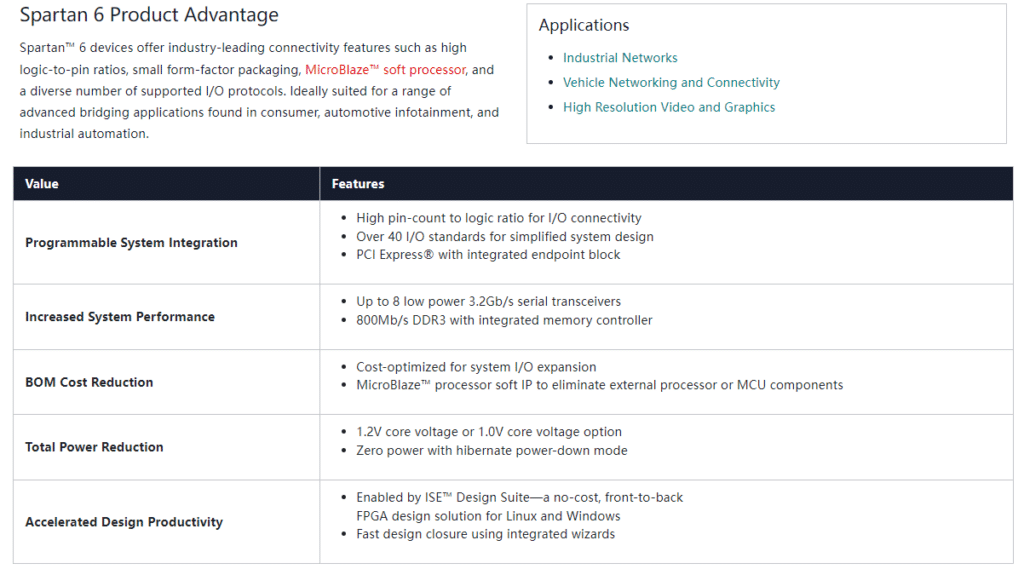
The Pioneers: A Deep Dive into Xilinx’s Legacy FPGA Series
Hey FPGA enthusiasts! We’ve been knee-deep in the Virtex UltraScale, 7, and 6 series, haven’t we? Feeling a bit swamped with all the tech jargon and data sheets? Yeah, me too. So, let’s switch gears for a moment. Why, you ask? Well, partly because I’m still buried under a heap of technical docs, and also, let’s be honest, who doesn’t love a good cliffhanger?
Taking a Step Back
Before we dive back into the nitty-gritty, let’s give a nod to the classics. They might not be stealing the spotlight anymore, but they’re the unsung heroes that set the stage for today’s FPGA marvels. In this chapter, we’re keeping it brief—just a quick rundown, not an encyclopedia. So, buckle up!
Virtex-5
Technical Specifications:
- Logic Cells: Up to 330,000
- Max Frequency: Up to 550 MHz
- I/O Pins: Up to 1,200
- Power Consumption: Around 10 to 25W depending on the configuration
The Virtex-5 series was a versatile powerhouse in its heyday, particularly excelling in video processing tasks. With its high logic cell count and a maximum frequency of up to 550 MHz, it was designed for high-performance applications. If you were into video compression or real-time video analytics a few years back, you’d likely have encountered this series. Its high-speed I/O capabilities, with up to 1,200 pins, and robust logic density made it a go-to choice for a variety of applications, from industrial automation to data centers.
What set Virtex-5 apart was its adaptability. You could configure it for a multitude of tasks without breaking a sweat. I remember using it for a project that required real-time sensor data processing, and it performed flawlessly. While its power consumption could range from 10 to 25W depending on the configuration, it was a small price to pay for the performance it delivered.
Though it’s no longer in production, the Virtex-5 series has left an indelible mark on the FPGA landscape, particularly in how we handle video data today.
Virtex-4 Series
The Virtex-4 series, a true workhorse in its time. This series was introduced back in 2004 and was one of the first FPGAs to offer multiple platforms within the same family—LX for high-performance logic, FX for embedded processing and serial connectivity, and SX for high-performance DSP applications.
- Up to 200,000 logic cells
- Built-in PowerPC 405 processor cores in FX series
- Up to 840 DSP slices
- RocketIO MGTs for high-speed serial I/O
- Advanced clock management with up to 12 DCMs (Digital Clock Managers)
What I appreciate about the Virtex-4 series is its balanced approach. It didn’t try to be the best at everything but offered solid performance across various domains. It was the kind of FPGA you could rely on for a broad spectrum of tasks, from communications to robotics. If you were stepping into the FPGA world around the mid-2000s, chances are you’ve had some hands-on experience with this series.
Virtex-II Pro Series
Next up, let’s talk about the Virtex-II Pro series, a line that truly set the stage for multi-functional FPGAs. Launched in 2002, this series was a big leap forward, integrating not just logic and memory but also high-speed RocketIO transceivers and IBM’s PowerPC cores.
- Up to 3 million system gates
- Embedded IBM PowerPC 405 cores
- RocketIO multi-gigabit transceivers
- Up to 556 user I/O pins
- Advanced SelectRAM memory hierarchy
The Virtex-II Pro series was a Swiss Army knife of sorts in the FPGA world. It was versatile, powerful, and ahead of its time. I’ve seen it used in everything from industrial automation systems to early IoT devices. Its multi-gigabit transceivers were a game-changer for applications requiring fast data transfer, like video streaming or network routers.
Virtex-II Series
Before we had the multi-functional Virtex-II Pro, there was the Virtex-II series. Introduced in 2000, this series was all about pushing the envelope in terms of logic density and performance.
- Up to 6 million system gates
- Up to 556 user I/O pins
- SelectRAM+ memory hierarchy
- 3D IC stacking capabilities
- DDR SDRAM memory interface support
The Virtex-II was the kind of FPGA that you’d find in high-performance computing back in the day. It was a go-to for applications that needed to crunch a lot of data but didn’t have the luxury of space. I’ve seen it used in scientific simulations and even some early machine learning prototypes. The DDR SDRAM support was a big deal back then, making data-heavy tasks more manageable.
Virtex-E Series
Ah, the Virtex-E series, a true classic in the FPGA world. Launched in 1999, this series was designed to offer a balanced mix of performance and features, making it a versatile choice for a variety of applications.
- Up to 1.5 million system gates
- Up to 412 user I/O pins
- SelectRAM memory hierarchy
- 3.3V and 2.5V dual-voltage operation
- Built-in clock management
The Virtex-E was a staple in many early embedded systems. Its dual-voltage operation made it a popular choice for battery-powered devices, and the clock management features were a lifesaver for optimizing performance. I’ve seen it in action in everything from industrial automation to early IoT devices. It was the kind of FPGA that gave you a lot of bang for your buck.
Conclusion: Why Xilinx Matters to Us and You
I wrote this article not just because I find Xilinx FPGAs interesting, but also because they’re a big part of what we do at Rowsum. We have strong connections in this area, making it easier for us to help you with your FPGA needs.
We’ve covered a lot, from the latest Virtex series to the classics that paved the way. If you’re considering using Xilinx FPGAs for your projects, I hope this guide has been helpful.
If you have any questions or need further information, feel free to reach out to us at [email protected]. We’re here to help.

